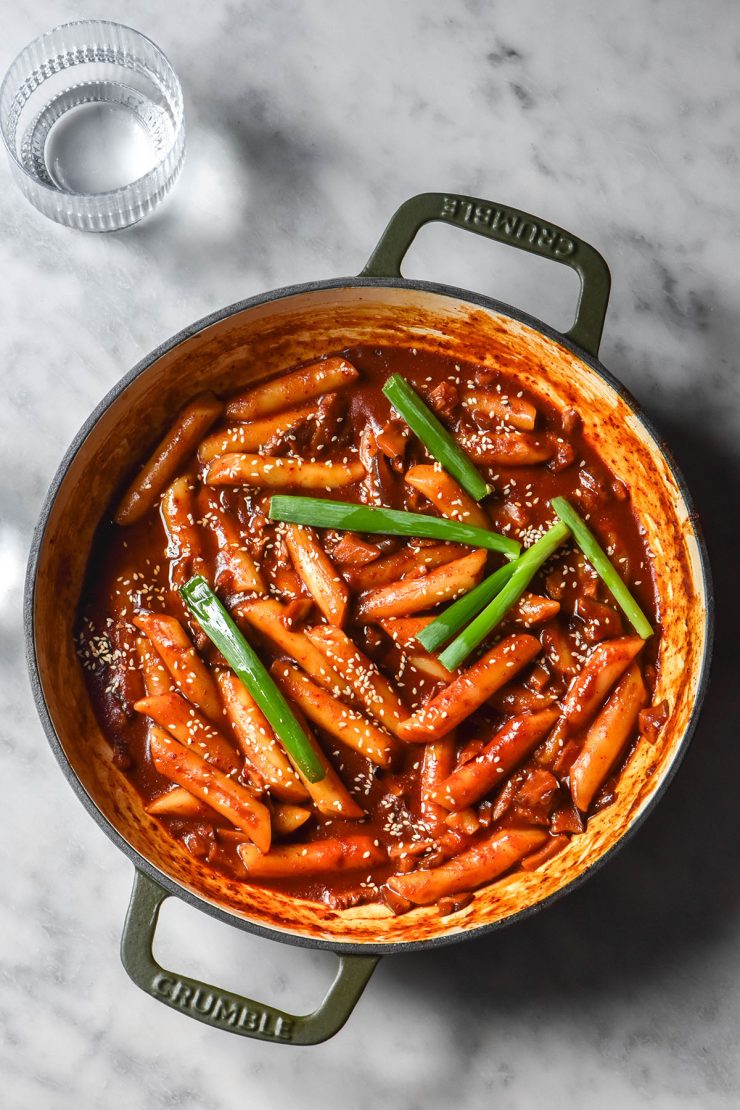
I recently returned from a glorious trip to South Korea. We visited Seoul and Busan and I absolutely adored both cities, the people and the food. Now that I’m back, I am excited to be in the kitchen whipping up gluten free, vegetarian/vegan and low FODMAP versions of the delicious Korean food I ate while I was away.
Vegan Tteokbokki (gluten free, low FODMAP option)
A quick note, before we dive in. I am not Korean and I never want to take from a culture or offend in developing Korean recipes. My aim is to provide options for those with dietary requirements that might otherwise prevent them from trying Korean food. I struggled as a gluten intolerant vegetarian in Korea and my goal is develop dietary friendly versions of Korean classics so that people like me can enjoy them too.
To borrow from The Korean Vegan, ‘means rice cake (“tteok” or 떡) that is stir-fried (“bokki” or 볶이).’ It is a Korean street food made with rice cakes cooked in a sweet and spicy gochujang sauce.
As the tteok or rice cakes cook, they release starches into the cooking broth. This starch thickens the broth and creates a beautiful, glossy sauce that soaks in and coats the rice cakes perfectly.
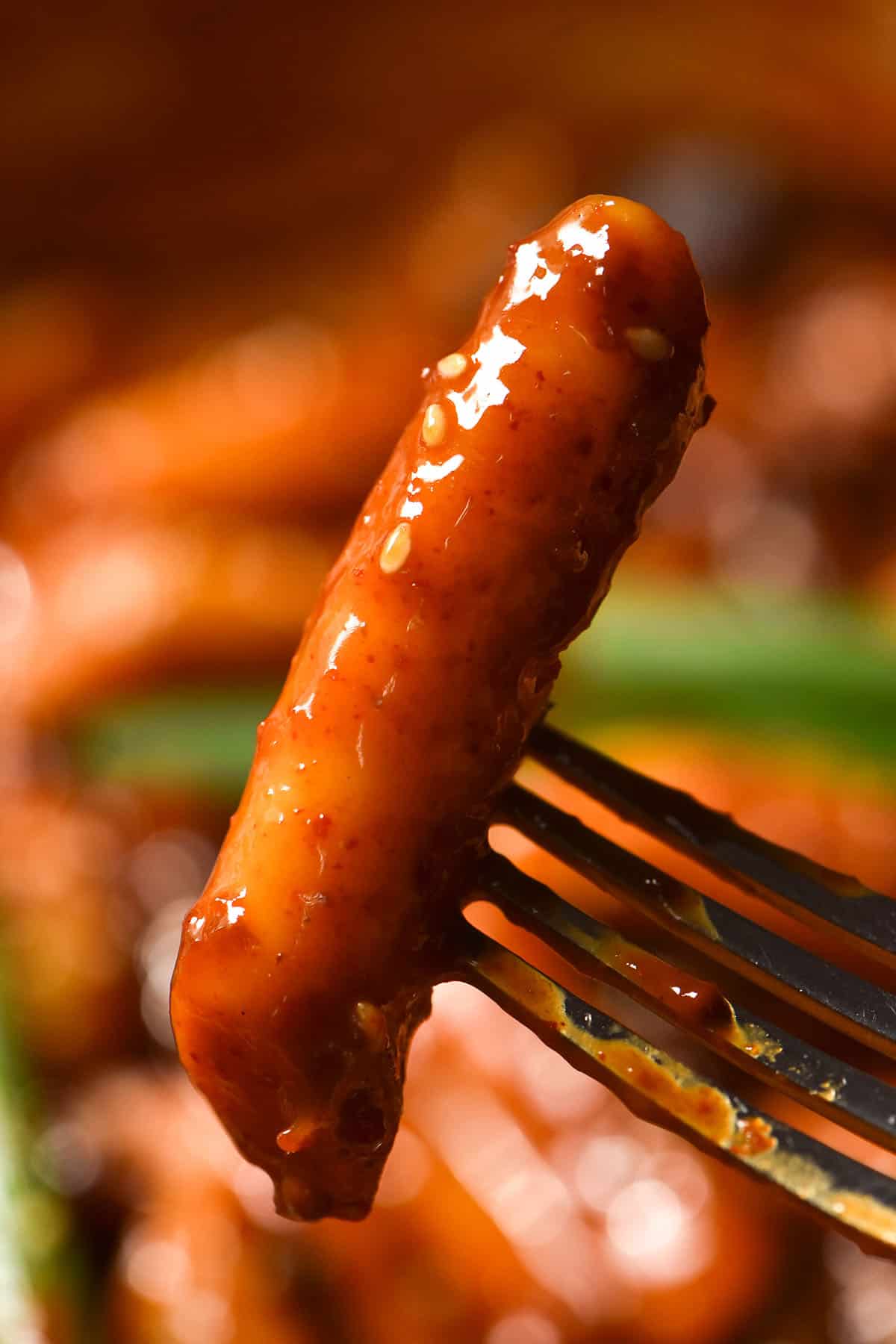
How does this recipe differ from traditional tteokbokki?
Traditionally, tteokbokki is made with an anchovy style broth, added Korean fish cakes and traditional gochujang.
This version uses dried shiitake mushrooms for an umami broth alternative. A lot of recipes use dashima/kombu seaweed to achieve an umami broth. However, I wanted to try and make the recipe a bit more accessible for people like me who don’t have easy access to kombu. Dried shiitake mushrooms are available at the big supermarkets in Australia and go a long way in adding depth of flavour to your broth.
Korean fish cakes (eomuk) are made with fish, seafood, wheat flour and often wheat starch. As such, I have simply omitted them from the recipe. I added a bit of vegan fish sauce to replace the light fishy flavour (I love Vincent The Vegetarian brand). You could also use a finely sliced block of fried tofu to replace the fish cakes.
Finally, the gochujang. Gochujang is traditionally made with barley and fermented over many months. Store bought varieties that are shortcut versions still contain wheat and thus gluten. I have developed a cheats gluten free gochujang recipe to use here an in other gluten free Korean recipes.
All in all, this recipe is not traditional but I hope it does the traditional version justice!
Some great resources on Korean cooking and food include:
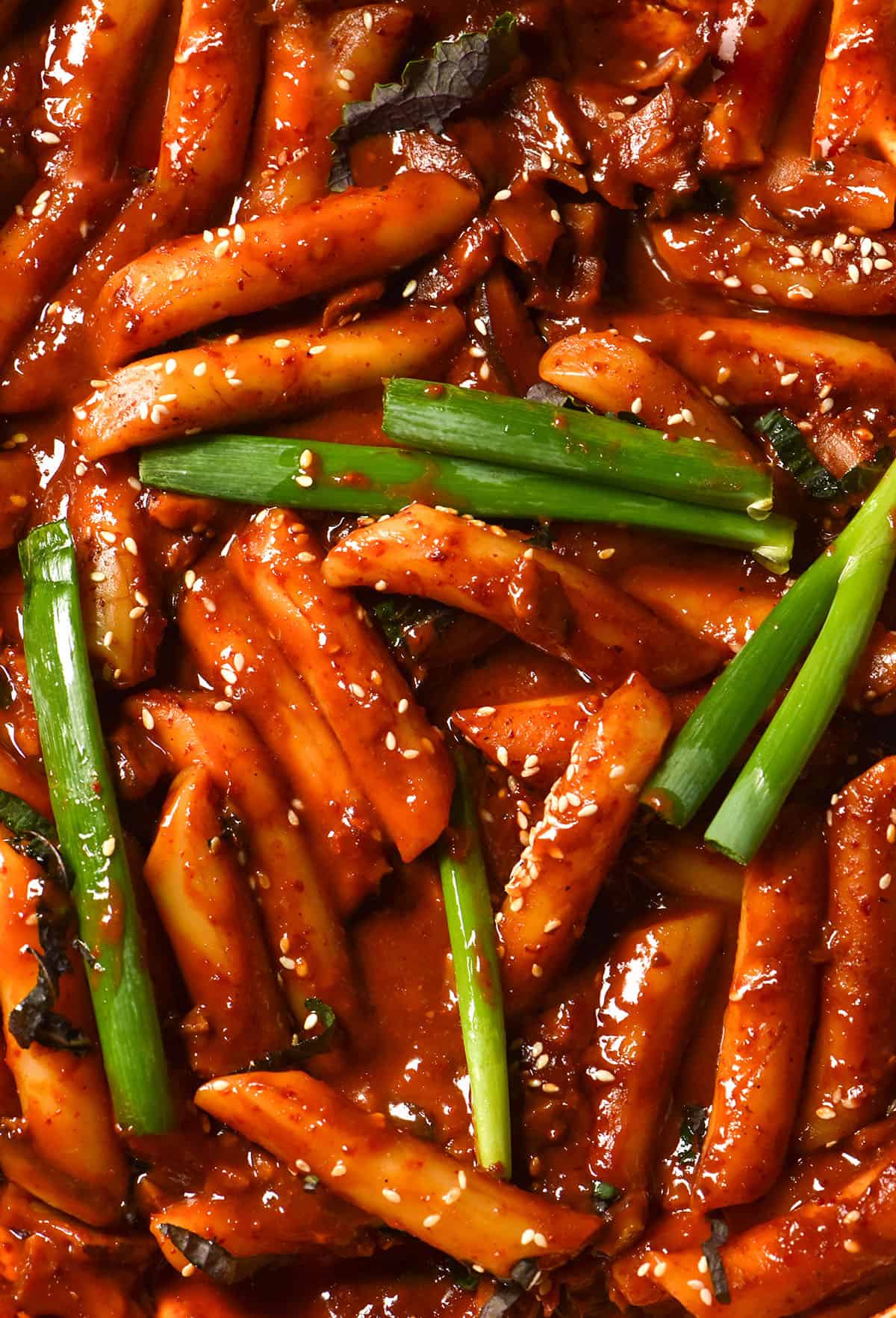
Tips and tricks for your vegan Tteokbokki
You don’t have to soak tteok but it does give them a chewier and softer texture. I didn’t soak mine and they cracked along the edges a little bit (not visible or tangible in the final result, though) so I wonder if soaking might avoid this. It didn’t make a difference to the final product at all, but is something I noticed.
You can make your sauce as thick or thin as you prefer it. I prefer mine to cling to the tteok and have a thicker, sauce-like consistency as you can see in the photos. If you prefer a thinner, soupier sauce, just add the larger volume of water. To that end, add water any time you feel like the dish needs it. No rules!
You can remove the shiitake from the water after the soaking time. I keep them in because I’m not about to waste shiitake, but it is an option. I like to remove them from the soaking water, chop them finely and return them to the pan to be cooked through.
On that note, I have seen some recipes adding vegetables and even tofu to the mixture. This makes it a great complete dinner and also uses up vegetables in the fridge. You’ll need to adjust the cooking times to ensure your vegetables cook through. I would recommend slicing sturdy vegetables like carrots finely to ensure they cook through. Another thing I would recommend is to add the larger volume of water if you add extra veg.
Some fried tofu sliced finely would make a good vegan substitute for eomuk (Korean fish cakes). You could experiment with soaking them in some vegan fish sauce prior to use, but I just add some fish sauce to the broth.
Add your gochujang to taste. If you are using a really spicy paste (they vary from brand to brand) use less to suit. Note that the colour of the sauce will change depending on how much you add and the colour of your gochujang. If you want to add more heat, use more gochujaru (Korean red chilli flakes).
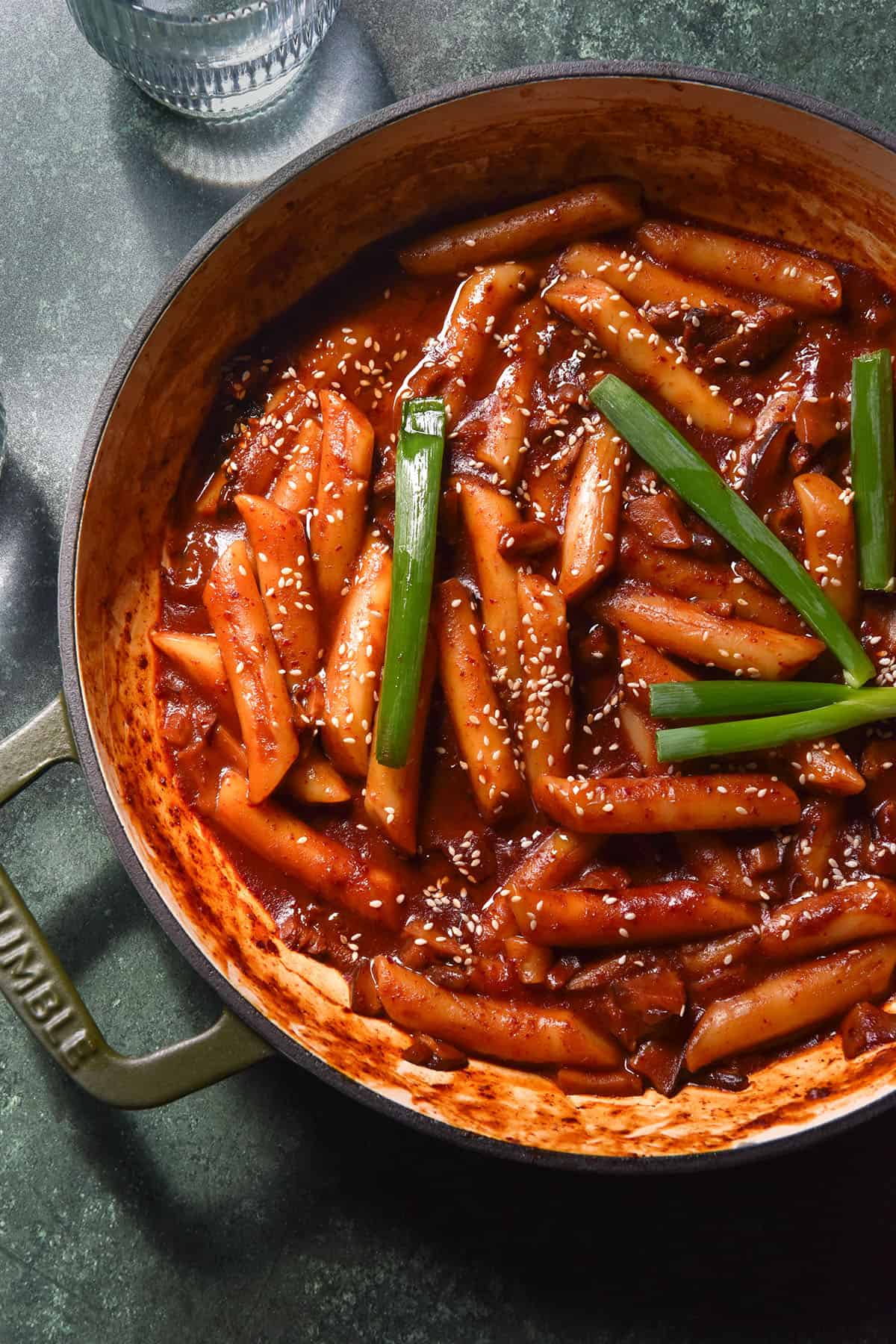
Ingredient notes for your vegan Tteokbokki
- You can buy Korean rice cakes at Asian supermarkets in packaged or frozen form. Check the ingredients to ensure they are made with rice flour or glutinous rice flour. Wheat flour seems to sneak into products you don’t expect these days. Of course, if you don’t need them to be gluten free, this is no issue.
- To keep this recipe gluten free, you’ll need to make your own gluten free gochujang. I have a recipe here (it’s very inauthentic!).
- To make your own gluten free gochujang, you will definitely need gochujaru (Korean red chilli flakes). They have a floral, subtle chilli flavour and add gorgeous colour. Their spice level and flavour are very different to the chilli flakes sold in Australian supermarkets. I buy mine from my local Asian supermarket, but you can also buy them online. By all accounts they differ dramatically in their heat level and it might be hard to decipher if you can’t read Korean. I have Hosan brand at the moment and I’d say they are pretty mild.
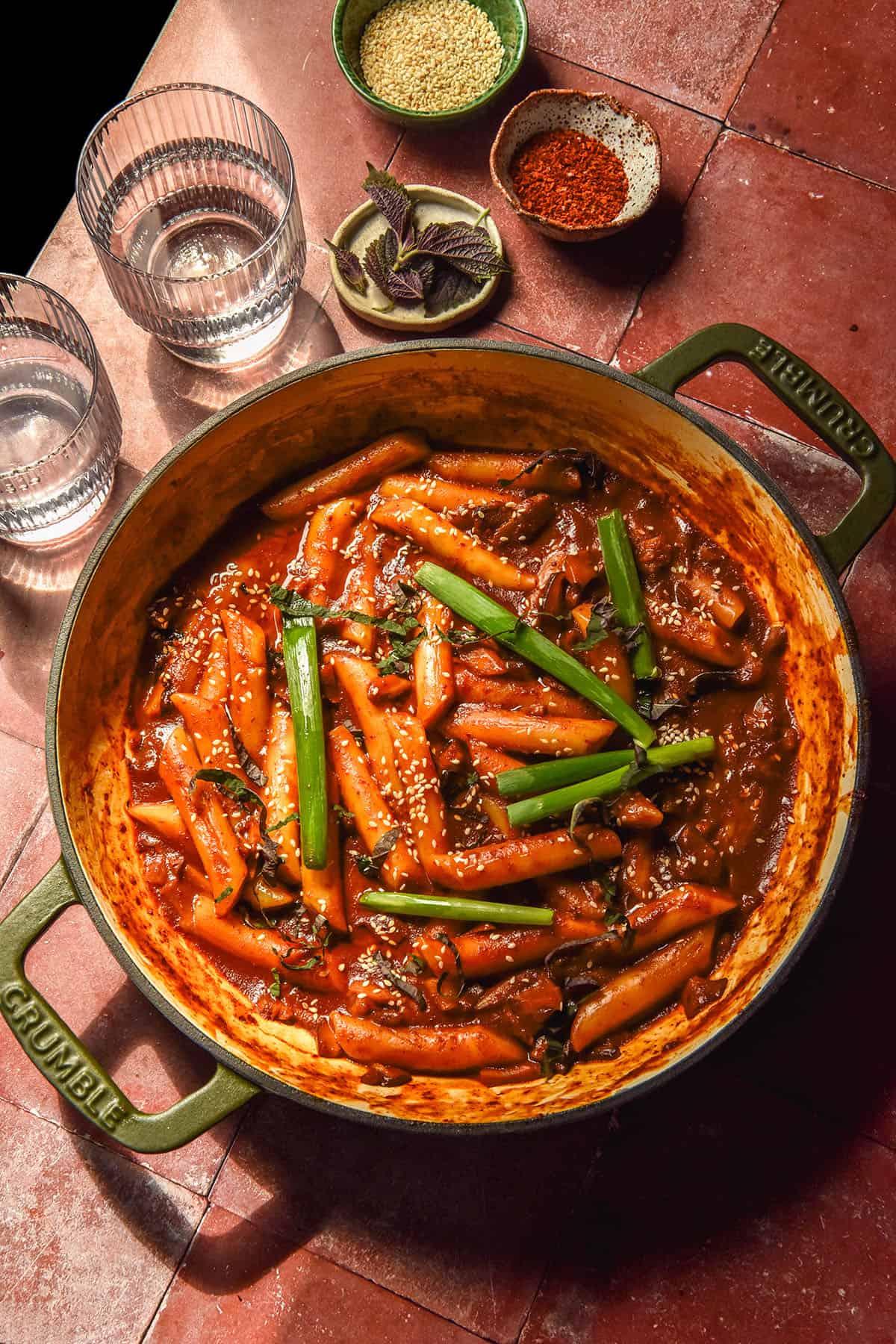
FODMAP notes
I didn’t necessarily design this to be a low FODMAP recipe, but it can be made lower FODMAP with some tweaks. Firstly, you’ll need to use a low FODMAP gochujang paste. I have a recipe on my Substack here. Keep in mind that this is lower fructose but it is still on the high end of fructose.
These FODMAP thresholds are current as of late May 2025 and will be periodically updated to ensure they remain accurate.
Dried shiitake mushrooms are low FODMAP in 8g serves. In 13g serves, they contain moderate amounts of mannitol. This recipe uses 10-20g and serves 4.
White rice flour is low FODMAP in 100g. Monash doesn’t currently give an upper limit, but white rice itself is low FODMAP in up to 500g. Unless something changes during the processing, it stands to reason that white rice flour is low FODMAP. Make sure you check the label of your rice cakes to ensure they contain rice/ rice flour and not much else.
Spring onion greens are low FODMAP in 75g serves. In 97g serves, they contain moderate amounts of fructose. It’s worth keeping in mind that the chilli in gochujang contains fructose, so you might want to limit or omit the spring onions here depending on your tolerance.
If you choose to add any extra vegetables or proteins to your tteokbokki, make sure they are low FODMAP.
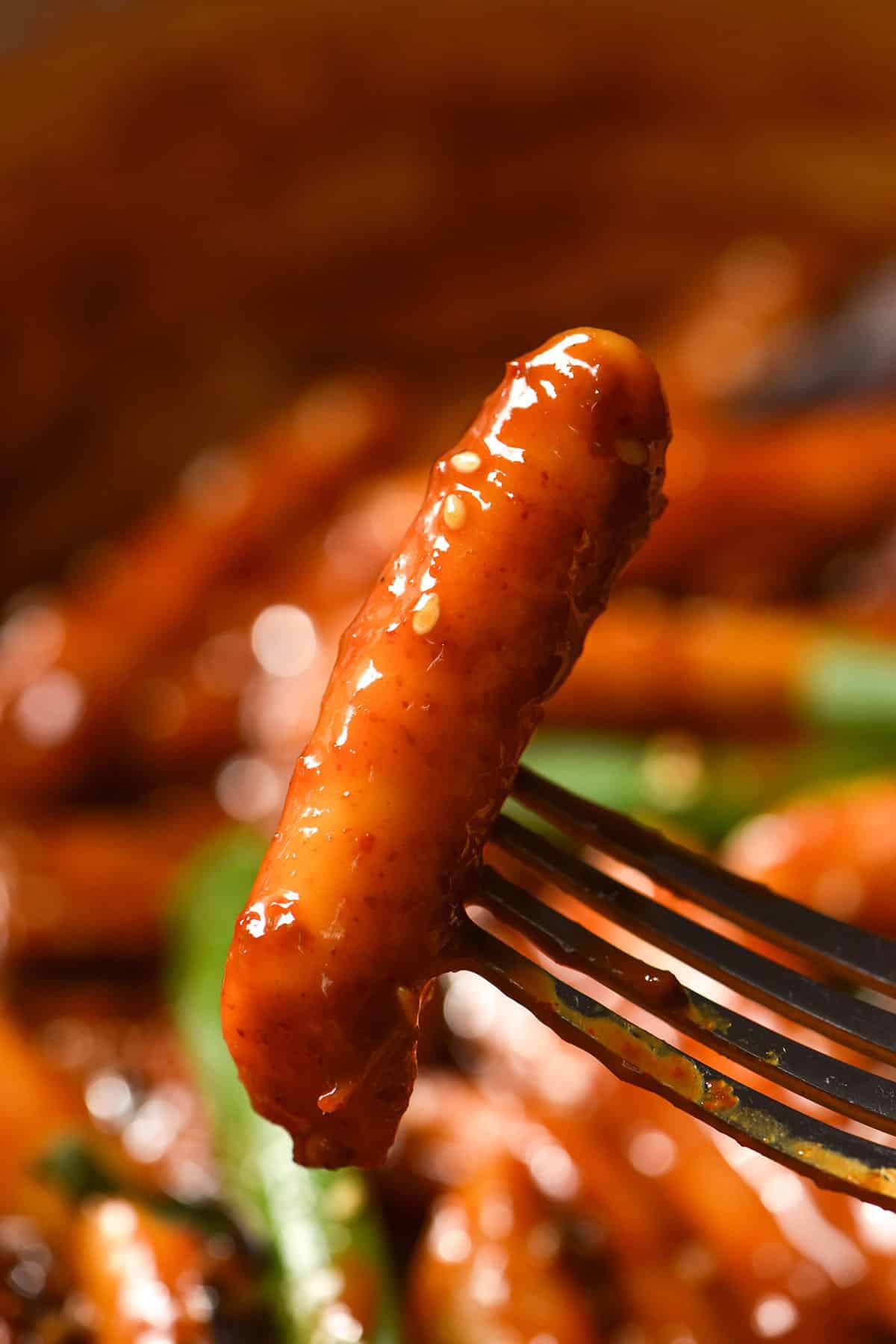
More gluten free, vegetarian or vegan and low FODMAP Korean inspired recipes
- Gluten free gochujang paste
- Low FODMAP gochujang paste
- Gluten free, vegetarian or vegan Bibimbap (low FODMAP option)
- Low FODMAP vegetarian rose tteokbokki
- Gluten free gochujang risotto (low FODMAP option)
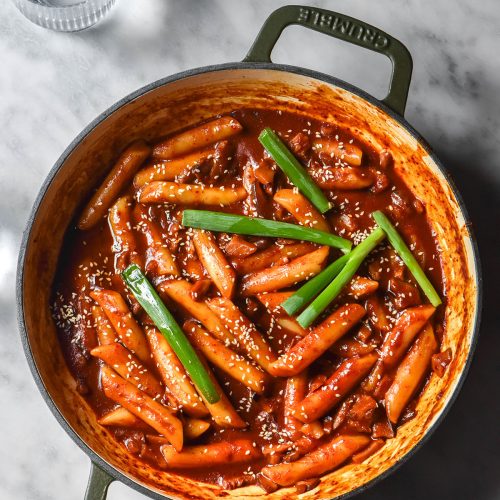
Vegan gluten free Tteokbokki
Ingredients
For the gluten free vegan tteokbokki:
- 500-750 ml water see notes
- 20 g dried shiitake
- 500 g tteok (Korean rice cakes, the cylindrical kind as opposed to the flat circles) (make sure they are gluten free if needed)
- 3-4 spring onion greens
- 3-4 Perilla leaves optional, I just had them on hand
- 75 g gluten free gochujang paste see notes for link to my cheats recipe
- 20 ml (1 tablespoon)* gluten free soy sauce or Tamari, plus more as needed
- 20 ml (1 tablespoon)* gluten free vegan fish sauce, plus more as added I use Vincent the Vegetarian
- 20-40 ml (1-2 tablespoons)* maple syrup, to your tastes
- 5-10 ml (1-2 teaspoons) rice wine vinegar optional but adds a bit of brightness
- Seasoning to taste
- Extra gochujaru flakes, to your tastes
To finish:
- Toasted sesame seeds
- Toasted sesame oil
- Spring onion greens optional
- Finely sliced perilla leaves optional
Instructions
- Measure the water and shiitake into a large open casserole dish or skillet that you intend to cook your tteokbokki in. Set aside for 30 minutes to allow the dried shiitake to soften and infuse the water.
- If you are soaking your tteok (rice cakes), add them to a large bowl of room temperature water and set aside.
- After the soaking time, scoop the shiitake out of the broth and give them a good squeeze to release extra flavour into the broth. You can discard them but I prefer to chop them finely and return them to the broth.
- Add the spring onion greens and optional perilla leaves to the shiitake broth and turn the heat to medium. Allow to come to a simmer before adding the gochujang, gluten free soy sauce or Tamari, fish sauce and maple syrup.
- Stir to combine and create a bright red broth, then add the tteok (rice cakes).
- Cook the tteokbokki over a medium heat, stirring intermittently, until the sauce starts to bubble and thicken. Once it has, taste the sauce and adjust according to your preferences. Add the seasoning, gochugaru and anything else you think the dish needs.
- Allow the sauce to thicken to your desired preference – whether that be a thick, paste-like sauce or more of a soupy consistency.
- Top your tteokbokki with toasted sesame seeds, a good drizzle of toasted sesame oil and some optional spring onion greens. Serve immediately for best results because the tteok harden as they cool.
- To reheat, add a splash of water and heat on the stove or in the microwave. Leftovers keep well in the fridge in an airtight container for a number of days.
Notes
- How much water you adds depends entirely on your preference sauce wise. I like a thick sauce, but you might prefer a thinner one.
- You might also be adding extra vegetables or sliced tofu, so adjust the liquid content accordingly.
- Soaking your tteok might also change how much liquid you need to add. Because soaked tteok likely have absorbed liquid, you may need to add less if you choose to soak it prior to use.
- You can find my recipe for gluten free gochujang (cheat’s version) here.
- You can find my recipe for low FODMAP gluten free gochujang here.
- Tteokbokki should have a spicy, sweet and complex flavour. Add all ingredients to your tastes – this is your dish! If you need to add more of something, go for it.
- I highly recommend drizzling over the toasted sesame oil at the end. It brings everything together so well. Perilla oil would also be great here but it’s much less accessible where I live.

Love your recipes! I know you prefer vegetarian cooking, but it would be great if you could add a low fodmap recipe with meat sometimes 😉